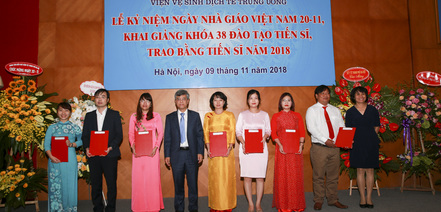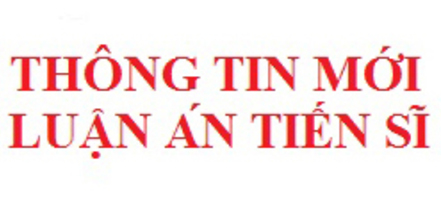THÔNG TIN VỀ CÁC KẾT LUẬN MỚI LUẬN ÁN CỦA NGHIÊN CỨU SINH BÙI THỊ MAI HƯƠNG
THÔNG TIN VỀ CÁC KẾT LUẬN MỚI CỦA LUẬN ÁN
Tên đề tài: “Thực trạng chăm sóc sức khỏe sinh sản của phụ nữ người dân tộc và hiệu quả hoạt động của cô đỡ thôn bản tại Ninh Thuận”
Thuộc chuyên ngành: Vệ sinh Xã hội học và Tổ chức Y tế. Mã số: 62 72 01.64
Họ và tên nghiên cứu sinh: Bùi Thị Mai Hương Khóa: 32
Họ và tên hướng dẫn khoa học: 1. PGS. TS. Nguyễn Tuấn Hưng;
2. GS.TS.Đặng Đức Phú
Cơ sở đào tạo: Viện Vệ sinh dịch tễ Trung ương
Tóm tắt những kết luận mới của luận án
1. Thực trạng kiến thức và thực hành CSSKSS của phụ nữ DTTS tỉnh Ninh Thuận.
Có 67,4% bà mẹ khám thai trạm y tế, Có 51,6 % các bà mẹ khám thai đủ 3 lần, 81,8% bà mẹ tiêm phòng uốn ván, 72,2% khám thai tại trạm y tế xã. 50,85% được hướng dẫn đăng ký để quản lý thai nghén bởi nhân viên y tế thôn, bản/CĐTB,
28,3% phụ nữ có thai không sinh ở cơ sở y tế. Lý do không đến CSYT để sinh do điều kiện đi lại khó khăn chiếm tỷ lệ cao nhất với 31,75%. Người hỗ trợ sinh chủ yếu là người thân (42,06%). Còn tới 7,14% và 7,49% là mụ vườn hoặc tự đỡ.
78,3% bà mẹ được chăm sóc tại nhà 6 tuần đầu sau đẻ. 96,17% bà mẹ được hướng dẫn cách nuôi con bằng sữa mẹ. Về người chăm sóc sau đẻ và hướng dẫn nuôi con bằng sữa mẹ: cán bộ y tế thôn, CĐTB, bản chiếm tỷ lệ cao nhất (61,7% và 43,1%). Có 88,3% các bà mẹ đã được hướng dẫn về KHHGĐ; 81,19% bà mẹ được khám phụ khoa định kỳ, chủ yếu tại trạm y tế xã (83,58%).
2. Đánh giá hiệu quả can thiệp tăng cường CSSKSS thông qua hoạt động của CĐTB .
Tỷ lệ bà mẹ có kiến thức về khám thai ≥ ba lần sau can thiệp 61,4% (CSHQ=68,5%). Kiến thức của các bà mẹ về số lần tiêm phòng uốn ván ở lần mang thai đầu tiên là hai mũi SCT 70,2% (CSHQ: 10,4%). Hiểu biết của đối tượng nghiên cứu về các dấu hiệu nguy hiểm có thể gặp phải khi mang thai đều tăng lên. Tỷ lệ khám thai từ 3 lần trở lên 68,8% sau can thiệp (CSHQ: 33,4%).
Tỷ lệ hiểu biết về những người đỡ đẻ tốt nhất, kiến thức về các dấu hiệu nguy hiểm trong khi chuyển dạ tăng. Tỷ lệ phụ nữ sinh con tại cơ sở y tế 88,1% (SCT), CSHQ=30,7%. bà mẹ sinh con do nữ hộ sinh ở trạm y tế đỡ đẻ TCT 31,0%, SCT 65,1% (CSHQ=105,4%). hiểu biết với từng biểu hiện nguy hiểm sau sinh khá cao, đạt từ 61,6% đến 75,7%SCT
Đánh giá của phụ nữ dân tộc về CĐTB sau can thiệp đã tốt hơn so với trước can thiệp. Trong đó, có CSHQ cao nhất là việc CĐTB đã có tranh/ảnh tuyên truyền về các biện pháp tránh thai (tỷ lệ TCT chỉ là 24,5%, SCT; 67,1%). Ngoài ra, tỷ lệ CĐTB tư vấn tuyên truyền, vận động, thực hiện CSSK bà mẹ khi mang thai, sau khi sinh và hướng dẫn thực hiện kế hoạch hóa gia đình cũng được cải thiện SCT, với CSHQ đạt từ 25,5% đến 47,8%.
Hà Nội, ngày tháng năm 2019
Đại diện người hướng dẫn GS.TS.Đặng Đức Phú | Nghiên cứu sinh Bùi Thị Mai Hương |
INFORMATION ABOUT NEW FINDINGS OF THESIS
Thesis title: "The situation of reproductive health care for ethnic minority women and the effectiveness of activities of village midwives in Ninh Thuan province"
Specialization: Social hygiene and Health organisation. No: 62 72 01.64
Name of PhD student: Bui Thi Mai Huong Education course: 32
Doctoral advisor: 1. Assoc. Prof. MD. Nguyen Tuan Hung;
2. Prof. MD.Dang Duc Phu
Training Institution: National Institute of Hygiene and Epidemiology
Summary of new findings of the thesis:
1. Status of knowledge and practice of reproductive health of ethnic minority women in Ninh Thuan province.
There were 67.9% of mothers antenatal care at health stations, 10% went to private clinics. 51.6% of mothers had antenatal care enough 3 times, 81.8% of mothers had tetanus vaccination, 72.2% of antenatal care at commune health stations. 50.8% of mothers were instructed to register for pregnancy management by village health workers, village midwives; 28.3% of pregnant women did not go to health facilities. Reasons for not going to health facilities to give birth due to difficult transportation conditions accounted for the highest proportion (31.7%).
78.3% of mothers were looked after in the first 6 weeks after giving birth at home. 96.2% of mothers were taught how to breastfeed their babies. Regarding postpartum care and breastfeeding instruction: village health workers and village midwives accounted for the highest proportion (61.7% and 43.1% respectively).88.3% of mothers had been instructed on family planning; 81.2% of women between the ages of 15 and 49 had regular gynecological exams, mainly at commune health stations (83.6%).
2. Effective interventions to strengthen reproductive health care through activities of VILLAGE MIDWIVES in Ninh Thuan province.
The proportion of mothers with knowledge about 3 times or more antenatal care was only 36.4%, the number of post-intervention increased to 61.4% (Efficiency index = 68.5%). The mothers' knowledge about the number of tetanus vaccinations in their first pregnancy was two doses increased from 63.6% to 70.2% (Efficacy index: 10.4%). The understanding of the study subjects about the danger signs that can be encountered during pregnancy increases. The rate of ≥ 3 times antenatal care examination increased to 68.8% (Efficacy index: 33.4%).
It is also better for mothers and mothers to have knowledge about danger signs during labor. The percentage of women giving birth at health facilities has increased, reaching 88.1% (post-intervention), efficiency index = 30.7%. Regarding midwives for mothers, women who gave birth by midwives at the CHCs only 31.0%, increased to 65.1% (post-intervention) (Efficiency index = 1005.4%). Effective index of knowledge with each dangerous manifestation after birth is quite high, reaching from 61.6% to 75.7%.
The assessment of ethnic women of reproductive age at post-intervention was better than before the intervention. In particular, the most effective indicator was that village midwives has had pictures/photo propaganda on contraception (the proportion of pre-intervention was only 24.5%, post-intervention: 67.1%). In addition, the rate of village midwives always present when calling, always graciously taking off, taking care of good birthing and talking about maternal and child health care issues also improved at post-intervention, with the fruits reach from 25.5% to 47.8%.
Ha Noi, 27 December 2019
Doctoral advisor Prof. MD.Dang Duc Phu | PhD student Bui Thi Mai Huong |
Tải file tóm tắt luận án Tiếng Việt tại đây:
Tom_tat_Luan_van_tieng_viet_-_NCS__Bui_Thi_Mai_Huong.pdf
Tải file tóm tắt luận án Tiếng Anh tại đây:
Tom_tat_Luan_van_tieng_anh_-_NCS_Bui_Thi_Mai_Huong.pdf
Tải file luận án tiến sĩ tại đây:
Luan_van_NCS_Bui_Thi_Mai_Huong.pdf








